Fall allergies are usually triggered by mold and ragweed. Exposure can trigger annoying symptoms such as sneezing and watery or swollen eyes. Based on some studies, it reveals that warmer temperatures can produce higher pollen count and promotes the growth of pollen-producing plants.
https://www.youtube.com/watch?v=KmY863Cy-QE
Aside from runny nose and itchy eyes, fall allergies can also trigger an itchy throat, swollen eyelids, nasal itchiness and hives. Some experience fatigue and irritability. Among those who have severe ragweed allergies, asthma symptoms are triggered such as wheezing, coughing and chest tightness.
How to control the symptoms of fall allergies
Luckily, those who have fall allergies do not necessarily have to skip out any events during this season. There are several measures that can help manage the symptoms.
Avoid any garden or yard work
Those who have fall allergies should avoid any kind of yard work. Remember that big piles of leaves or mulch are ideal breeding places for mold particularly if it is damp outdoors. Even mowing or raking the yard can worsen the symptoms.

Daily workouts in the evenings
An afternoon jogging routine is not suitable for those who have fall allergies. The level of pollen in the air is high between 10 AM – 3 PM. Exposure during this period can trigger the uncomfortable symptoms of fall allergies such as runny nose, itching and swelling. It is recommended to switch to an evening workout instead since the pollen count is low.
Allergen-free environment
- A dehumidifier should be purchased that is placed in damp parts of the house such as the basement. This helps prevent the growth of mildew and mold.
- Change the air filters before increasing the heat for the first time to minimize dust mites. Regularly wash bedding and blankets as well.
- Always keep the doors and windows closed to prevent outdoor allergens from entering the house.
Wash away the allergens
A hot shower can rinse away pollen and other allergens from the skin and hair. Washing clothes that were used outdoors can eliminate them. It is also vital to wash hands throughout the day to prevent pollen from entering the nose and mouth when the face is touched.
Nasal rinse
A nasal rinse can be used at the end of the day after spending time outdoors to get rid of some of the pollen present in the nose.
The nasal rinses which are similar to the neti pot work by flushing out the nasal passages with warm water or a saline solution. The solution or water flushes out pollen, dust, mucus and other triggers that can worsen the symptoms of fall allergies.
